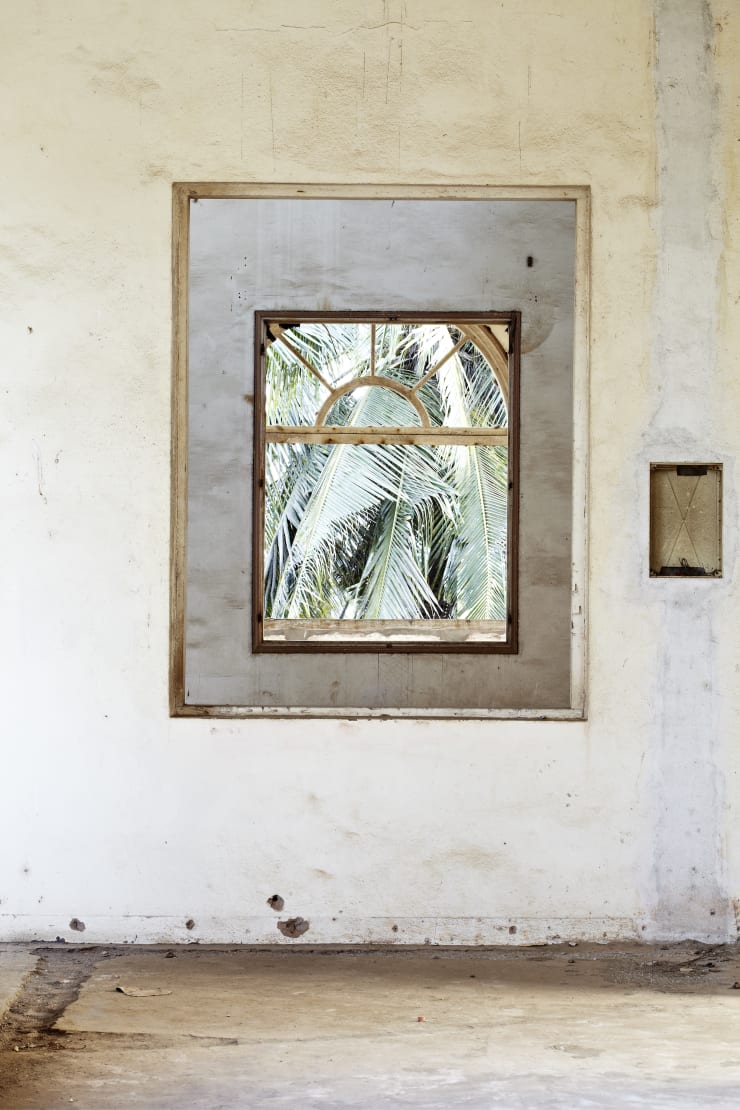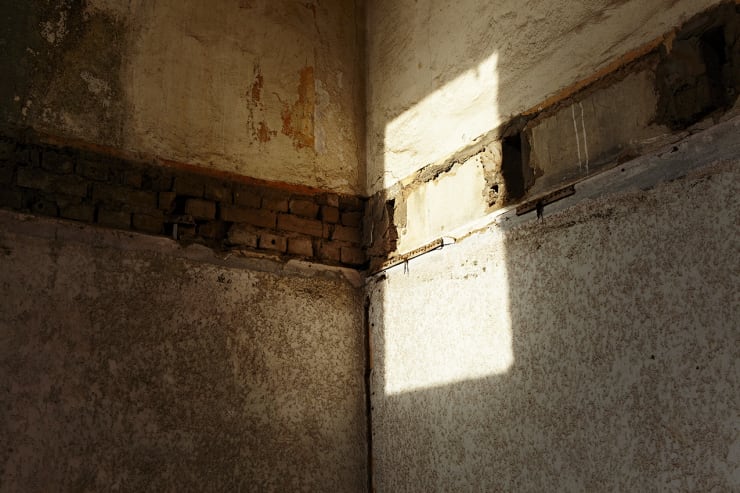-
Know more about the artist
This week, we invite you to discover Palais du gouverneur #5, Lomé, Togo, a photograph by François-Xavier Gbré, a Franco-Ivorian artist born in 1978 in Lille, France.
Francis Corabœuf, director of the offices and showroom in Paris, offers us a personal reading of this work. -
To access a selection of the artist's works, click here
A frame within a frame. Lines, channels. After a period of observation, spots that turn out to be breaches in a wall. Twisted shapes that hang or rise. A brief moment of loss of bearings. Finally, a clue: a fragment of moulding in the bottom left corner. We're looking at a ceiling.
In 2012, François-Xavier Gbré photographs the Palais du Gouverneur in Lomé. As is often the case, the subject of his attention and research is an architecture that encompasses a larger environment. Built by the German colonial forces at the beginning of the 20th century, the palace was the residence of German and then French governors, and later became the seat of the presidency of the Togolese republic from 1960 to 1970. It remained a place of power until the early 1990s, when it was abandoned for a new building. By the time François-Xavier Gbré entered it, the place was in ruins and guards had to be present to enter.
François-Xavier Gbré builds his works as he would probe History. His investigations have led him to dissect and analyse emblematic buildings from the colonial and independence periods in West Africa, such as the Olympic swimming pool at the Modibo Keita Stadium in Bamako (2009), the former National Printing Office in Porto-Novo (2012) and the former Palace of Justice in Dakar (2014-16). The built heritage is a valuable source of information, and its observation reveals what words cannot carry, traces, these strata of time and history. This methodical approach allows him to question, through architecture, the status of the historical heritage of West African countries, by showing their evolution as many questionings or possible ways of evolution.
-
In this massive construction of the governor's palace, François-Xavier directs our gaze to forgotten corners. By approaching architecture and space in a radical, almost abstract way, he creates an outline that reveals the elegance of tiny constituent details: the suspensions of the false ceiling, damaged or torn off, the cavities in the walls or this piece of moulding that illustrates the decorum of the past grandeur of the place. This rigid composition exacerbates the qualities of the materials, be it the heaviness of the dust deposited on the walls, in a powdery and fragile, immobile sensation, or the contrast between the white surface of the painted walls and their abrupt interior of cement and concrete.
The notion of time stratification takes on a tangible dimension, from the imprint of the collapsed false ceiling to the digging of the inside of the walls. In this building in particular, François-Xavier Gbré plays with the expected angles of view and stops, echoing the photograph of the ceiling, on the floor in Palais du Gouverneur #3. In this work, a few drops of liquid dissipate the veil of dust that covers a antique tile floor. The colours come back to life and this difference between two states gives a glimpse of a testimony of the place, at a moment in the past. Voluntarily, the photograph of the ceiling is not given immediately, as in many photographs where François-Xavier Gbré searches for a point of view that confuses the shots and makes the reading of the image more complex, a metaphor for the complexity of the story itself, or its inaccessibility - a reconstruction that can be found in Palais du Gouverneur #4 where the ruin becomes a labyrinth with an inverted geometry, but still bearing this wealth of materials and sensations... These works were later exhibited in dialogue with each other, notably in 2017 in the exhibition Recent Histories at the Walther Collection (New-York - Neu Ulm).
Approaching this work finally allows me to echo the recent opening of the Governor's Palace, restored and open to the public as an arts and culture centre. The walls that surrounded it have been demolished and the premises have acquired a new destination, outside the direct field of power for which the palace was built. The invitation to come and capture the place before renovation was made to François-Xavier by the director of the Palais Sonia Lawson. The photograph of the ceiling is now a testimony of another bygone stage of the place, which has now become the Palais de Lomé.
-
Available works - A selection
-
 François-Xavier Gbré, Palais du gouverneur #1, Lomé, Togo, 2012
François-Xavier Gbré, Palais du gouverneur #1, Lomé, Togo, 2012 -
 François-Xavier Gbré, Palais du gouverneur #2, Lomé, Togo, 2012
François-Xavier Gbré, Palais du gouverneur #2, Lomé, Togo, 2012 -
 François-Xavier Gbré, Palais du gouverneur #3, Lomé, Togo, 2012
François-Xavier Gbré, Palais du gouverneur #3, Lomé, Togo, 2012 -
 François-Xavier Gbré, Palais du gouverneur #4, Lomé, Togo, 2012
François-Xavier Gbré, Palais du gouverneur #4, Lomé, Togo, 2012 -
 François-Xavier Gbré, Palais du gouverneur #5, Lomé, Togo, 2012
François-Xavier Gbré, Palais du gouverneur #5, Lomé, Togo, 2012 -
 François-Xavier Gbré, Palais du gouverneur #7, Lomé, Togo, 2012
François-Xavier Gbré, Palais du gouverneur #7, Lomé, Togo, 2012 -
 François-Xavier Gbré, Palais du Gouverneur #8, Lomé, Togo, 2012, 2012
François-Xavier Gbré, Palais du Gouverneur #8, Lomé, Togo, 2012, 2012 -
 François-Xavier Gbré, Palais du Gouverneur #9, Lomé, Togo, 2012, 2012
François-Xavier Gbré, Palais du Gouverneur #9, Lomé, Togo, 2012, 2012 -
 François-Xavier Gbré, Palais du Gouverneur #12, Lomé, Togo, 2012, 2012
François-Xavier Gbré, Palais du Gouverneur #12, Lomé, Togo, 2012, 2012 -
 François-Xavier Gbré, Palais du Gouverneur #13, Lomé, Togo, 2012, 2012
François-Xavier Gbré, Palais du Gouverneur #13, Lomé, Togo, 2012, 2012
-
Focus sur / Palais du gouverneur #5, Lomé, Togo - François-Xavier Gbré: Partez à la rencontre du travail d'un artiste à travers l'analyse d'une de ses œuvres
Past viewing_room










